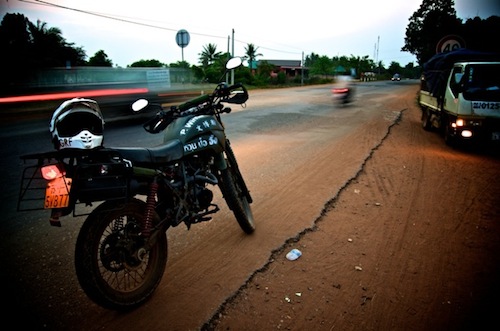
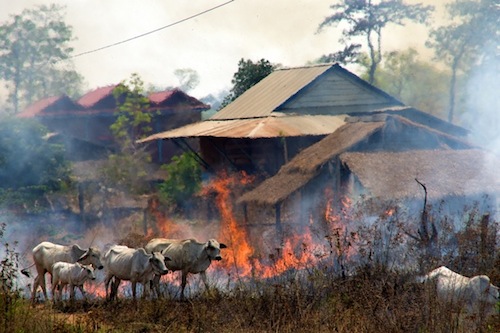
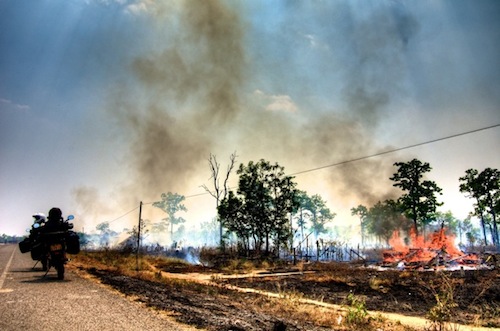
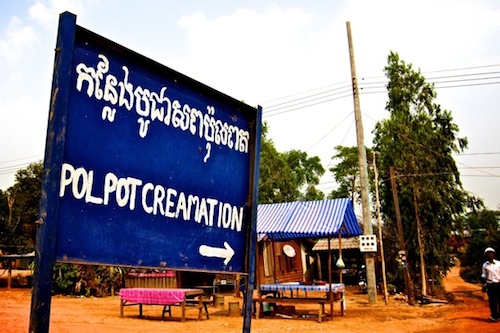
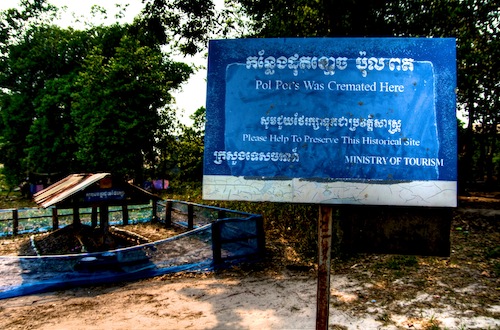
By Peter Winter
Rider, Writer
The Huffington Post
Posted: March 26, 2011
Some days start with the sun shining through the window, the warm light welcoming you to a brand new day of possibilities. You are energized, ready to seize what's in front of you. Moods are contagious, and the rightness of your mind makes the world right. It's a good day.
Some days start with dark grey, the bland skies urging you back to bed. There's nothing particular wrong with the day, but you never feel like it's quite started. You wake up unhappy, go to work unexcited, come back unsatisfied, go to sleep unfulfilled. Nothing goes right, and your mood carries over to all things around you. It's a lost day.
But today leaves me puzzled. I am happy yet sad, thankful but outraged, lost and somehow found. When you don't know what you are looking at, you don't know how to feel about it.
Cambodia's modern history is one of pure tragedy. From 1975 to 1979, Pol Pot and the Khmer Rouge were responsible for three million murders, a third of the country knocked off in one of the most brutal "social" campaigns ever attempted. Brother Number One, as Pol Pot was affectionately known in his classless society, ordered the deaths of intellectuals, artists, minorities, foreigners, and everyone in between, cleansing the country of its undesirable elements. Through endless torture and mass execution, society would be made pure again, a perfect communist state where the taint of imperialist tradition would be replaced with revolutionary culture. Year Zero marked the beginning of the new Cambodia.
When the regime finally fell, a trail of darkness was left across the entire country. From the Killing Fields in Siem Reap to the horrors of Phnom Penh's S-21, the devastation of the Khmer Rouge era stares at you unrelenting in its gaze. Every corner of Cambodia has some remnant of the past's violence, its history indelibly stained with blood.
There is no sense in horror like that. And when you attempt to look at it, it is impossible to understand what it all means.
We loaded up the bikes early. Our destination for the day was Prasat Preah Vihear, a mountaintop temple currently the sticking point between Thai and Cambodia military forces. A 2008 UNESCO decision to list the site as a Cambodian World Heritage Site led Thailand to fire mortars across the border, apparently claiming the temple by inflicting damage all around it. In the past few years, several soldiers on both sides have been killed, the most recent just this February. We were told it was safe now, and never the ones to turn down an adventure, Hans and I made the foolhardy decision to go.
It was the journey to Preah Vihear, however, that left us speechless.
The temple route crossed through Anlong Veng, a town in Cambodia's far northwest that until 1998 was held by the Khmer Rouge. Pol Pot and his fledgling forces fled here in the 1980s, laying mines throughout the region to keep out the encircling Vietnamese. It was here that Pol Pot died in 1998, not in a way fitting one of history's greatest mass murderers, but as an old man of seemingly natural circumstances. There is a story that he was taken out by angry associates after he ordered the execution of a revered officer, but at the age of 72, he lasted longer than he should have. Outside Anlong Veng, his body was hastily cremated, a funeral pyre of old chairs and coffee tables.
As we rode out of Siem Reap, we quickly caught up to the darkness we were chasing. Traffic was heavy along the small roads, the whir of infinite scooters dipping between heaving cargo trucks. The occasional private car would blow by at double our speed, their urgency leaving the highways tense. Throughout Cambodia, people mill along the roadside, making the long strips of pavement more a center of life than simply a passage through it.
But the crowd ahead wasn't normal. There were too many for this small straightaway, too frenzied. People darted through one another just like the scooters, cranking their necks to see what was lying in the field.
Tucked deep within the crop field, the Land Cruiser's roof peered out like a scarecrow. Its body contorted unnaturally, the windows blown out across the dirt. The car's front pointed back to the road, staring at its former location. There were no people inside, help must have already come and gone. Judging from the blows across the heavy metal frame, not sure there were any people left when it came to its final resting place.
Hans and I slowed to a crawl, but there was nothing to do save stop and watch the wrecker pull it back to the road. So we kept moving, the crash scene a dark start to what was sure to be a dark day.
The sun was intense today. I had woken up energized by its warmth. I knew the day would be bring some grim history, but having visited Cambodia a few years back, I didn't expect that intense jolt of emotion that comes with one's first time. I wouldn't allow it, and the freedom that comes with riding motorbikes allows you to simply let things slip as you driver further and further away.
But then the fires started.
The dry season's heat leaves dead brush on the fields. A small fire is the easiest way to clear it out, and throughout our ride in this country, the image of burning golden fields has been a constant. Most are small campfires, clearly not going anywhere with the limited kindling. A house, quite oppositely, provides enough fuel for a serious blaze.
As we rode past a burning woodpile, we thought nothing of it. Just another stack of flames. To be perfectly honest, Hans and I were looking for the perfect backdrop for a magazine cover-worthy photo. We'd been asked to write about our ride for an adventure motorcycle magazine, and a shot with some sky-high flames behind our wheels would be perfect. We doubled back and parked on the roadside, the heat of the flaming pile steaming up our riding suits.
As I pulled my camera, I watched a group of guys climb up a wooden shack with cups of water. They were smiling as they dumped the cool water on the smoking wood. Across the street, a few women were carrying bundles of clothing, watching the fiery woodpile with little concern. One of the guys on the shack roof waved to us, eyeing our bikes with excitement. A herd of cows began to push onward into the smoky field, even less concerned by the scene around them.
"What is going on here?" I say quietly in my head
I continued to survey the scene. The brushfire was heading closer and closer to another shack, this time catching a hold of its wooden stilts. A group walked casually from the house, a handful of clothes in both hands. They turn their heads back, still without a hint of worry.
This wasn't supposed to happen. The houses weren't supposed to be burning down. But they were, and life just moved on through it. Do what you can to save the ones that aren't up in flames, move out of the ones that are. Keep pushing on, don't worry, and don't look back. I snapped a few pictures, and we rode on. There wasn't anything to involve ourselves in. Heck, the residents weren't even involved. What would be a scene of absolute agony in my country, watching my house burn down, was just another day here.
We rolled into Anlong Veng in the noon heat. The ride had left us starved, and we huddled under an umbrella with five other guys, munching on streetside sandwiches. The men made fun of my body armor by knocking on the hard plastic, a normal occurrence everywhere I go. A young guy pulled up his shirt to show me the long scar across his side. He chuckles, and I show him a scrape across my knee. He admires and gives a nod of approval.
We needed some directions, but how exactly do you ask for directions to Pol Pot's grave? I mean, it's easy to form the words, but I couldn't help but wonder what the reaction would be from this group of middle-aged Cambodian guys? "Why the hell would you go there?" they must be thinking. But no, they simply say "Pol Pot that way," and point us ahead with a smile.
20 kilometers further up a steep hillside, a blue sign marks the spot. "Pol Pot Creamation." I stared at the painted words as I pulled closer, trying to figure out why the misspelling made it sound so much worse. Lost in those letters, I paid no attention to the sloping road, and the bike came crashing to the dirt. I was still standing up, and it never really registered that I just dropped the 400lb motorcycle underneath me. Hans and I lift it back up and park to the side.
A skinny path leads up the green hillside. Tents dot the grass, orange hard hats dangling on the trees. A construction crew has set up home here, their trash sprawls out across of the small hill. Two young kids walk down toward us, sticks with water bottles dangling over their shoulder. The little girl smiles and passes right by. The smaller boy hesitates behind a wooden post, making sure its safe to walk by us once he knows his sister can.
A pile of dirt sits at the top. Rounded by empty glass bottles and covered by a small corrugated metal roof, the mound is unremarkable. Nothing about is important. Its place in this country's history will never lose its significance, yet its physical manifestation is exactly that -- a pile of dirt.
I stand without a clear thought in my head. A few more kids play to the side underneath a sign from the Cambodian Ministry of Tourism urging me to preserve this important historical site. A small incense burner at the mound's front sends a few grey puffs into the air. It is still around me, only a few pieces of trash wafting through the green grass.
I don't know what I'm looking at. In one thought, it is the fitting resting place of someone that is worth nothing more. Nobody in the tents seems to care who is lying here, why should I? In another moment, I wonder why it is not something grander, a monument to those lost at least. The incense confuses me. We were told that some locals still revere him. How? Am I even allowed to pass judgment?
Cambodia's people lived through all the horrors that Pol Pot brought upon them, and they've chosen to leave his grave insignificant. It seems fitting yet inappropriate, perfect but unworthy. I don't know how to feel because I didn't experience what he did, but nothing around me seems to signify its magnitude. The kids have run off now, their drawings in the ground linger on. But the grave just sits there, encapsulating everything and nothing in its form. It is, simply and unequivocally, a pile of dirt.
So we ride off the same way we left the car crash and the burning house. There is nothing to get involved in, nothing to worry about. The people around us are moving forward, and so should we.

1 comment:
Merci de votre commentaire dans Anlong Vègn et le détail sur le tombeau de Pol Pot.
Ce fou avait de la chance qu'on l'enterre . Ce qu'il fallait faire avec lui , c'est de laisser déchiqueter en morceaux par des chiens errants ou manger par des corbeaux !
Je ne trouve pas des mots pour les punir .
La famille entière de mon frère ( 10 personnes ) massacrée pour le motif " intellectuel" .Mon grand frère n'est qu'un infirmier dans un hôpital , il ne méritait pas une telle punition .Ma dernière nièce avait que 2 ans , tous tué et on ne trouve même pas l'endroit où le lieu où ces malades jetaient les corps.
Salot SAR ou POL Pot ne doit pas dormir tranquille . On doit aller uriner sur leur tombeau tous les matins et soir .
Post a Comment